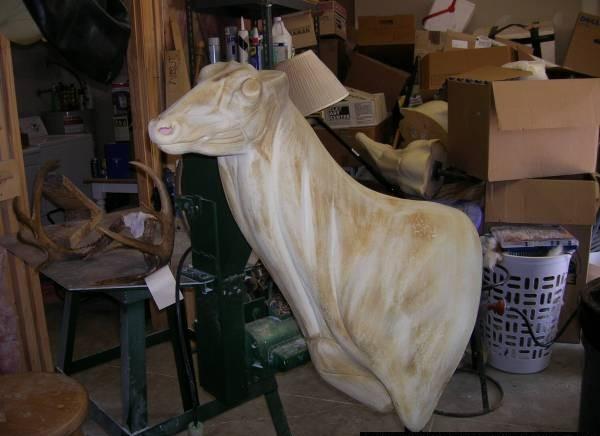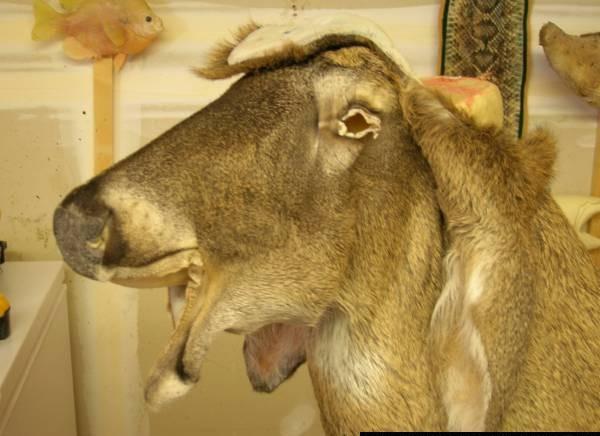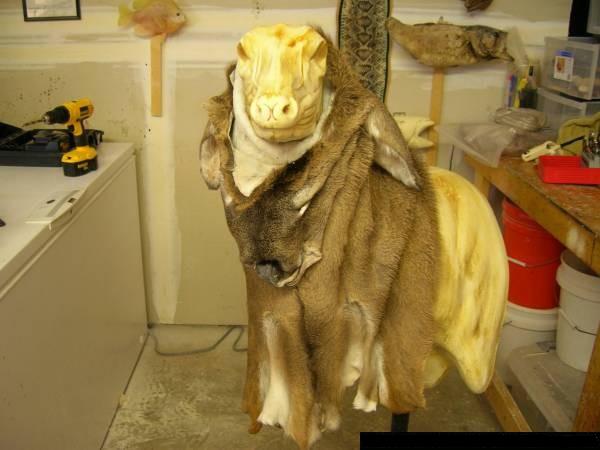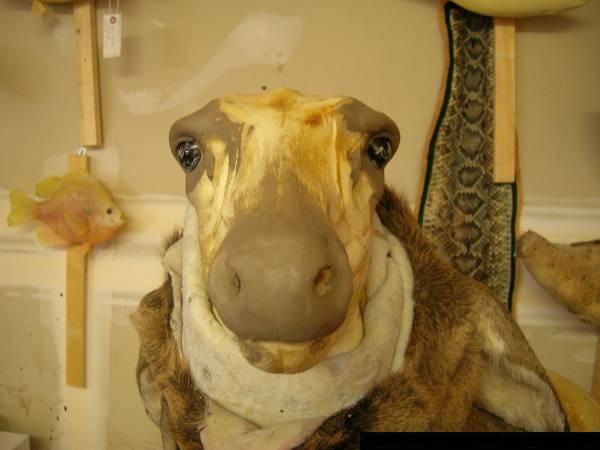Hunting-Washington.com
A Pacific Northwest Hunting Resource
Calling Bears | How to mount a Whitetail Deer | Bear Rug and Life Size Skinning Info | Fish Field Care

A Pacific Northwest Hunting Resource
Calling Bears | How to mount a Whitetail Deer | Bear Rug and Life Size Skinning Info | Fish Field Care
Well, I've had these pictures on my digital camera for a few
weeks now. These are just the basics, I didn't go into a whole lot of
detail. Basically this is how you mount a deer if everything goes
smooth and their are no bumps in the road along the way.
First off, when you first receive the deer you have got to cape it off
the skull. I use a "Y" Incision for this on all my deer. Their are a
few other ways of making your incision. One is a "T" Incision and very
few taxidermists like to make a "V" Incision and chisel the skull plate
off the skull.
"Y" Incision

"T" Incision

"V" Incision

Before you make your incisions you will need to measure the
cape. You will take 3 measurements "A" , "C", and "D". Your "A"
measurement will be from the tip of the nose to the front corner on the
eye. Your "C" measurement will be around the neck right behind the ears
and tight under the chin. Your "D" measurement will be 3" bellow the
ears. For this post we will use the following measurements A=7 1/2" x
C=21" x D=25".
The "Y" Incision and the "T" Incision are almost identical. The only
differance is the cut on top of the head. Basically what you do with
both incisions is once you have made the incision work the skin around
the antler bur either with a knife, scalpel blade or a screw driver.
Now sever the ear butts from the skull. Hold the front of the ear butt
as you cut the ear butt free from the skull making sure you keep this
knife as close to the skull as possible. This will hopefully help you
from cutting a hole through the cape.
Now work the cape down to the eyes. Put your finger into the back
corner of the eye. Now pull the skin outward while you continue to skin
the cape off the skull. Remember to keep the knife or scapel close to
the bone. This will keep you from cutting the delicate eye
skin while skinning the cape off the skull. Before you get to the mouth
flip the deer over so you can see the mouth. Now grab the lip and roll
it up. Work your knife around the jaw line. Keep in mind you want at
least 1/4" to 1/2" of inner lip skin left on the cape. You will use
this skin later.
Turn the head upside down so you can skin out the neck. Work the cape
all the way down to the head and neck junction and sever the spine at
the skull this will free the meat. You should only have the skull left
now you can finish taking the skin off the skull. Once you have
completed that you can now cut the horns off of the skull. Make your
cut straight down on the forehead about 1 inch infront of the horns. On
the back of the skull make your cut parallel with the eyes.
Once you get the cape off the skull you need to turn the eyes,
ears, nose, and lips. Be careful not to cut through the skin on either
of these areas because they are very thin and a pain in the rear to fix
if you are not experienced. Also remove all the meat and membrane off
the face. Now you have to flesh the main body of the cape. Get all the
red meat and membrane off of the cape. It doesn't have to be perfect if
you are going to tan the cape. If their is a little membrane left that
is alright.
For this next step you are going to need 25 lbs of NON- IODIZED salt.
The best place to get this is at a feed store. It might run you $5.00 a
50lbs bag. Remember you can never really use too much salt on a cape.
Now rub salt all over the cape. Make sure to get it into the creases.
If you don't get it in all the creases than it could cause hair
slippage in those spots.
Now lay the cape out flat and put a thin layer of salt on it. Now roll
the cape up and put in on an incline over night to allow it to drain.
Next day shake off all the old salt and rub some new salt onto the
hide. Lay the hide out flat on an incline and let it set for 2 more
days. If the salt is wet however the next day, change the salt with new
salt. After the 2 days are up you are ready to tan the cape.
In a 5 gallon bucket put 4 gallons of water and 4 lbs of salt. Mix the
solution until the salt is pretty much dissolved. Keep in mind not all
the salt is going to dissolve. Now place the cape in the solution until
it is soft again. Probably only take an hour or 2. While the cape is
rehydrating in the solution you can mix the pickle bath. I will not go
into detail because there are dozens of different pickles.
Once the cape is rehydrated put it in the pickle. Make sure the pickle
has a pH of 2. Leave the cape in the pickle for 3 days. On the third
day pull it out and shave it down. The pickle will cause a chemical
reaction in the skin and make it swell up almost 2x as big. Shaving it
means thinning the skin. Once you have shaved the skin put it back in
the pickle for 24 hours.
Now that the cape has been pickled it is time to neutralize it. Pull
the cape out of the pickle and allow it to drain while you mix the
neutralize bath. All you need is a 5 gallon bucket with 4 gallons of
water and 4 oz. of baking soda. Mix the solution up and place the hide
in it for no longer than 20 minutes. This will cause another chemical
reaction in the hide and cause it to swell up again. At this time you
can shave the cape once more.
Now you are ready to tan. I will not go into detail with this because
there are dozens of different tans. If I were using an EZ100 tan I
would mix up the tan making sure it had a pH of 4 before I place the
hide in. I leave the cape in the tan for 20-24 hours. Once I pull the
cape out I roll it up in a towel to get all the excess moisture off.
Than I take my tanning oil and rub it all over the skin side of the
hide. Turn the cape hair side out. Fold it up and put it in the frig
overnight. The next day it is ready to mount.
Now it is time to mount your deer. Use the measurements you
took off your deer ( A=7 1/2" x C=21" x D=25" ). Make sure when you
took these measurements that your tape measure was tight around the
neck. When I order a form I generally subtract 1" from the "C" and "D"
measurement. So I will be ordering a 7 1/2" x 20" x 24" whitetail
mannequin.
Once you recieve your mannequin you will need to test fit the cape on
the mannequin. It will slide on al ot easier if it isn't burned and
roughed up. Make sure the incision will come together in the back.
Now you will need to burn your mannequin. I usually use a small propane
torch. This will harden the mold release and it will sand off easier.
Once you have it burned you will need to sand down the face. Use a
dremal tool and cut slots for the tear ducts and around the lips for
the lip skin to tuck into. Use a Rougher to rough up the main body of
the form.

Now use a dremal tool or a knife or anything you prefer and dig out the foam in the nose. Don't dig out too much or you will have to repair that later. You will want to dig it back a bit in order to give depth to the nose. After you have completed that use your speed septum tool and install the speed septums in the nose, making sure they are centered.

Now it is time to install the earliners. Simply remove the
cartilage inside the ears. Insert the earliner and test the fit. If the
earliner is too big trim the edges until it fits. Once you get them
trimmed and fit right, mix your ear adhesive and smear it all over the
earliner and insert it back into the ear. Now work the skin around
until the hair line pattern is correct. Now set them aside and let them
set up.
Once the form is sanded and roughed up and the ears are set up go ahead
and slide the cape back on the mannequin. You will need to set the
antlers. Pull the cape up over the face and set the antlers on the
form. The skull plate on the horns should set flush with the top of the
mannequin's head. If not trim the bottom of the skull plate until it
does. All deer are different and their horns set different. some are
set farther back and others are closer to the eyes. For this post we
will go with the the average. Their should only be about 1 - 1/4 inches
of skull plate in front of the horns if not trim it as well. Once it
has been trimmed place the antlers on the mannequin and see if the skin
will reach up under the antler bur. If it does you are ready to bondo
the horns.

The horns need to be tilted properly on the head. You don't want them to be layed too far back or too far forward. I am not going to go into detail on this either. I will say an easy way to do this is measure from the tip of the nose to the tip of both main beams.

Once the bond is set up you will need to drill 4 holes. I use 4 - 3" drywall screws. You want the screws to slid into the holes but not too loose. Use a drill bit accordingly. Now use a 3/8 inch drill bit and counter sint the 2 front holes. The 2 back holes will be covered up with clay.
It is now time to set the eyes. First off pull the face of your cape off the mannequin. Like so.....

Now use a little bit of clay in the back of the eye to set
them in the mannequin. Make sure the pupils are parallel to the floor
if the deer is looking straight ahead. If the deer isn't that is a
whole new ball game and I can't go into much detail on that subject.
It's something you will learn over time.

Now take some clay in your hand and roll it out into a rope
about the size of a dime maybe a little smaller. Run the rope about 1/2
inch in front of the eye back around to the back of the eye. Now roll
another rope out until it is a little smaller than a pen. Run this one
along the bottom of the eye. Smooth it off with your finger. Keep a cup
of water handy to dip your fingers in; it makes it a whole lot easier
too smooth the clay. Now take a little piece of clay and insert it into
the front of the eye to fill in the gap and smooth it off as well. Once
you have the eye brow sculpted in, roll out a very thin piece of clay
and put it against the eye on the brow about 1 inch long. This will be
sculpted in as an eye lid.
Once you are finished with the eyes smear some clay on the nose to
smooth it out where you installed the speed septums. The nose pad of
the cape is so thin it will show any deformities on the mannequin. You
will want to put a small piece of clay in front of the tear duct as
well.
The clay work shold look like this after it is complete!


© 2008 Hunting-Washington.com